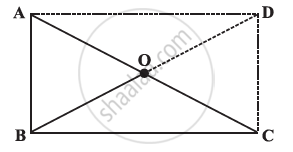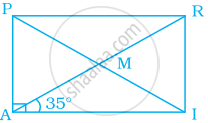Advertisements
Advertisements
प्रश्न
Draw a rectangle ABCD such that l(AB) = 6.0 cm and l (BC) = 4.5 cm.
उत्तर
Steps of Construction:
Step 1: Draw AB = 6 cm.
Step 2: Draw ∠ABX = 90º.
Step 3: With B as centre and radius 4.5 cm, draw an arc cutting the ray BX at C.
Step 4: With C as centre and radius 6 cm, draw an arc.
Step 5: With A as centre and radius 4.5 cm, draw an arc cutting the previous arc at D.
Step 6: Join AD and CD.

Here, ABCD is the required rectangle.
संबंधित प्रश्न
ABC is a right-angled triangle and O is the mid point of the side opposite to the right angle. Explain why O is equidistant from A, B and C. (The dotted lines are drawn additionally to help you)

In Fig. 17.29, suppose it is known that DE = DF. Then, is ΔABC isosceles? Why or why not?
Which of the following statement is true for a rectangle?
It has all its sides of equal length.
Draw a rectangle whose one side measures 8 cm and the length of each of whose diagonals is 10 cm.
A mason has made a concrete slab. He needs it to be rectangular. In what different ways can he make sure that it is rectangular?
Using opposite angles test for parallelogram, prove that every rectangle is a parallelogram.
If the diagonals of a parallelogram are of equal lengths, the parallelogram is a rectangle. Prove it.
A parallelogram PQRS is constructed with sides QR = 6 cm, PQ = 4 cm and ∠PQR = 90°. Then PQRS is a ______.
In rectangle PAIR, find ∠ARI, ∠RMI and ∠PMA.

A line l is parallel to line m and a transversal p intersects them at X, Y respectively. Bisectors of interior angles at X and Y interesct at P and Q. Is PXQY a rectangle? Given reason.
